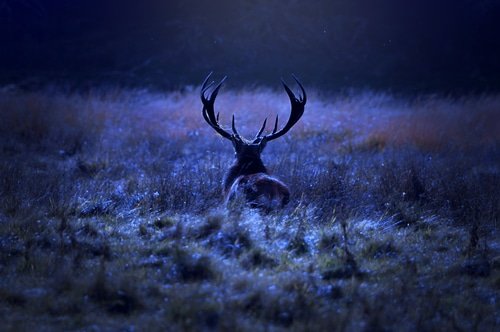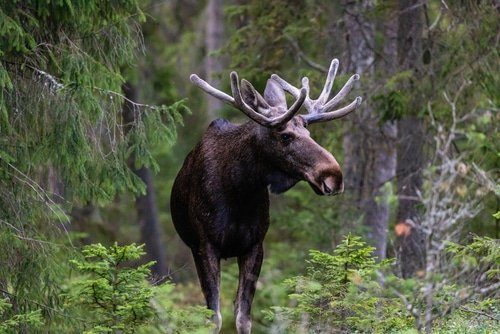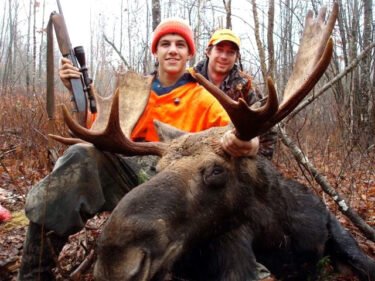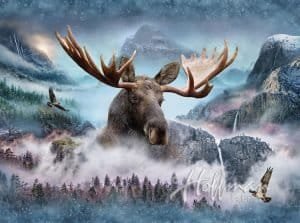Majestic and elusive moose are magnificent creatures that roam the vast wilderness of North America. These gentle giants typically inhabit boreal forests, wetlands, and mountainous regions. Their towering stature and impressive antlers make them well-adapted to survive in harsh environments. So, are you interested in learning moose tracking techniques? Let’s do it!
Importance of tracking for research and conservation efforts
Tracking moose is an exciting adventure and serves crucial research and conservation purposes. By following moose trails in the wilderness, scientists can gather valuable information about the population dynamics of these magnificent creatures. Tracking provides insights into their migration patterns, food preferences, mating habits, and overall health conditions.
This data helps wildlife biologists assess the impact of environmental changes on moose populations and develop conservation strategies. Moreover, tracking allows researchers to monitor individual moose using radio telemetry or DNA analysis to understand their movements and behaviors better.
, Through this introduction to moose tracking techniques that provides a brief overview of their behavior and habitat while highlighting its importance for research and conservation efforts, one can already appreciate the significance of understanding these majestic creatures through detailed observation to protect them effectively.
Understanding Moose Tracks
Characteristics of moose tracks (size, shape, depth)
When it comes to tracking moose, understanding the characteristics of their tracks is crucial. Moose tracks are generally large and can measure up to 5 inches in length and 4 inches in width. The shape of the track is often described as heart-shaped, with a slightly rounded front and distinctly pointed toes at the back.
Due to their size, moose tracks can leave quite an impression on the ground, sinking up to 6 inches deep in suitable substrates like mud or snow. This depth can vary depending on various factors, such as the weight of the moose and the condition of the ground.
Differentiating moose tracks from other wildlife tracks
While it’s important to recognize moose tracks accurately, it’s equally important to differentiate them from other wildlife tracks that may be present in the same area. One distinguishing feature of moose tracks is their sheer size; they are significantly larger than most hoofed animal prints.
Additionally, pay close attention to the shape and arrangement of toes. Moose have cloven hooves split into two distinct toes, often leaving an indentation between them when they walk or trot.
This feature helps distinguish them from similarly sized animals like elk or deer with a more compact hoof structure without a pronounced cleft. By identifying these specific characteristics, you’ll be well-equipped to track moose and avoid confusion with other wildlife footprints you may encounter along your journey.
Identifying Moose Sign
Recognizing browse lines and stripped bark on trees
When you’re out there in the wilderness, following moose trails and tracking moose, one of the key things to watch is the telltale signs of their feeding habits. Moose are voracious eaters, leaving clear evidence of their munching ventures behind. One clue to look for is the presence of browse lines on trees.
These are horizontal marks on tree trunks where moose have stripped away the lower branches and twigs with powerful jaws. It’s almost like they’ve given these trees a stylish haircut!
Additionally, keep an eye out for stripped bark on trees. Moose will often scrape off bark sections to access nutrient-rich inner layers, leaving bare patches that stand out against the surrounding tree trunks.
Noticing hoof scrapes and droppings as indicators of moose presence
While browsing signs may be more obvious during certain seasons when vegetation is scarce, hoof scrapes and droppings are year-round indicators that can help you track down these majestic creatures. As you navigate moose territory, look closer at the ground beneath your feet. Hoof scrapes are shallow depressions in the soil made by a moose’s powerful hooves as it searches for food or marks its territory with scent glands located between their hooves.
These scrapes can be distinct and reveal important information about recent activity in the area. But don’t stop examining footprints; keep an eye (or nose) open for droppings, too!
Moose droppings are pellet-shaped, usually dark brown or black, blending well with the forest floor. If you notice a significant amount of fresh droppings along your path, chances are you’re getting closer to encountering these magnificent creatures in their natural habitat.
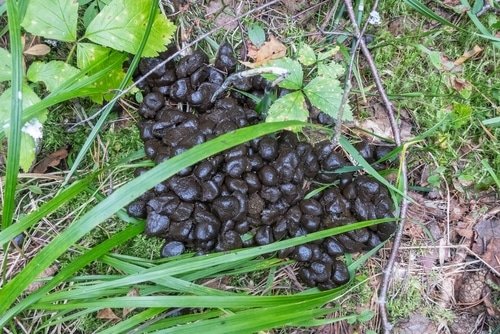
Tracking Methods for Moose
Visual tracking: following fresh tracks in snow or mud
When tracking moose, visual tracking is an essential skill in your arsenal. The first step is identifying fresh moose tracks in the snow or muddy terrain.
Look for large, round imprints with a pointed tip at the front, typically measuring up to 6 inches long and 5 inches wide. By observing the shape and depth of the tracks, you can determine the direction in which the moose has moved.
Fresh tracks will have well-defined edges, whereas older ones might appear more worn or debris-filled. Remember that sun exposure can affect track quality, making them harder to spot as they melt or become distorted.
Tips for identifying the direction and age of tracks
To accurately identify the direction of moose tracks, consider factors such as weather conditions and prevailing winds that may have affected how they appear. Tracks facing uphill are likely on a moose’s ascent, while those facing downhill indicate descent.
Additionally, look for other signs along the trail, like displaced vegetation or broken twigs, that can help confirm track direction. Determining track age requires some careful observation, too.
Fresh tracks will have sharp edges and distinct imprints without any evidence of melting or distortion caused by wind or animals crossing them. Older tracks may show signs of melting around their edges due to temperature changes or get partially filled with debris and leaves blown by the wind.
Utilizing binoculars to scan the surroundings for additional signs
While following moose trails on foot is undoubtedly exciting, sometimes taking a step back and scanning your surroundings with binoculars is beneficial. Binoculars allow you to spot additional signs that might not be immediately visible from ground level – such as browse lines on nearby trees where moose have stripped off bark and foliage to feed.
By carefully surveying the area, you may also spot hoof scrapes where moose have pawed at the ground and droppings that indicate their presence.
Audio tracking: listening for vocalizations and antler clashes
Besides visual cues, audio tracking can be a valuable technique for locating moose. Understanding different moose calls is fundamental in this pursuit.
Moose communicate with various vocalizations, including grunts, bellows, and mating calls. Familiarize yourself with these sounds through recordings or experienced trackers who can provide guidance.
Recognizing the sound of antlers colliding during rutting season
During the rutting season, male moose engage in fierce battles to establish dominance and win over females. These clashes result in distinct sounds that can be heard from quite a distance if you have a keen ear.
The sound of antlers colliding echoes through the forest, serving as an auditory beacon for your tracking endeavors. While audio tracking can lead you closer to potential moose sightings, it may not always guarantee visual confirmation.
Scat analysis: examining droppings to determine diet and health
Examining moose droppings might not be everyone’s idea of a glamorous activity, but trust us, it can provide invaluable insights into their diet and overall health.
Differentiating between male and female droppings based on size
Male and female moose produce different-sized droppings due to inherent physiological differences. Males typically leave larger scats that resemble elongated pellets or oval shapes measuring about an inch in diameter. On the other hand, female scats are smaller in size – usually rounded or bean-shaped with diameters around half an inch.
Interpreting the consistency and content of scat samples
Apart from size, the consistency and content of moose droppings offer additional clues. Fresh scats are moist and shiny, gradually drying out over time.
By examining them closely, you can gain insights into the moose’s diet. For example, if the scat contains plant fibers or leaf fragments, it indicates a herbivorous diet of browse such as leaves and twigs.
On the other hand, spotting partially digested grasses or sedges suggests a preference for grazing on grassy patches. Scat analysis plays a vital role in understanding moose feeding patterns and assessing their overall health status.
Abnormalities in consistency or the presence of parasites can indicate issues or diseases that may require further investigation by wildlife experts. Remember that while these tracking methods provide valuable information about moose behavior and presence, it is crucial to maintain a respectful distance and not disturb their natural habitats as we delve into the captivating world of moose tracking.
Advanced Tracking Techniques
Radio telemetry: Using radio collars to track individual moose
Radio telemetry is a cutting-edge technique that allows researchers to gain valuable insights into the movements and behaviors of individual moose. Scientists can monitor their location and activities by fitting moose with specially designed radio collars in real time. These collars are equipped with small transmitters that emit radio signals, which can be tracked using specialized receivers.
This technology has revolutionized our understanding of moose ecology by providing detailed data on their ranging patterns, migratory routes, and preferred habitats.
Explaining how radio collars work in monitoring movements
The radio collars used in moose tracking contain a battery-powered transmitter emitting continuous signals. These signals are picked up by antennas mounted on aircraft or ground vehicles, allowing researchers to triangulate the animal’s position. By regularly recording these locations over time, scientists can map out the movement patterns of individual moose and understand their response to environmental changes.
Discussing benefits and challenges associated with this method
The use of radio telemetry in tracking moose offers numerous advantages. It provides detailed information about an individual’s home range size, habitat preferences, and interactions with others within the population.
This enables researchers to develop more effective conservation strategies tailored to specific locations and demographic groups. However, there are also limitations to consider – such as the cost of equipment and personnel needed for data collection, potential interference from natural obstacles, or human infrastructure that may affect signal transmission quality.
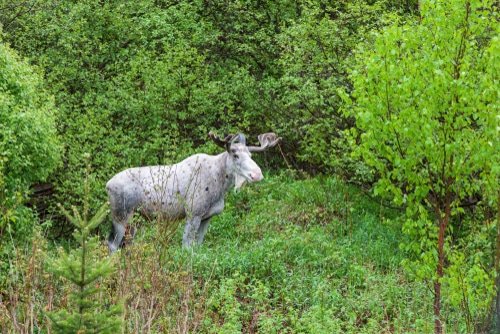
DNA Analysis: Collecting genetic samples for population studies
DNA analysis has emerged as a powerful tool for studying moose populations on a genetic level. By collecting genetic samples from hair snags or fecal matter left behind by these majestic creatures, scientists can extract DNA and analyze it to gain critical insights into genetic diversity, relatedness, and population structure.
This technique helps researchers understand the overall health and vitality of moose populations but also aids in making informed management decisions to ensure their long-term survival.
Describing methods such as hair snags or fecal DNA collection
One of the commonly used methods for collecting moose DNA is through hair snags. These are created by attaching strands of barbed wire or brush to a tree at a height that encourages moose to rub against it, leaving behind hair samples containing DNA.
Another approach involves collecting fecal matter left by moose, which can provide valuable genetic information without causing any harm to the animals. These samples are then carefully processed in a laboratory where DNA is extracted and analyzed using various molecular techniques.
Highlighting the role of DNA analysis in population studies
DNA analysis plays a crucial role in understanding population dynamics among moose. By examining genetic variation within and between populations, researchers can assess factors like gene flow, inbreeding levels, and genetically distinct subgroups known as subpopulations.
This information helps inform conservation strategies by identifying areas with high genetic diversity that may serve as important source populations for future recovery efforts.
Conclusion
Advanced tracking techniques such as radio telemetry and DNA analysis have provided us with invaluable tools for comprehending the intricate lives of these magnificent creatures. By following moose trails using radio collars and employing cutting-edge molecular techniques like DNA analysis from collected samples, scientists have made significant strides in understanding their movements, behavior patterns, and genetic diversity.
With this knowledge, conservation efforts can be tailored more precisely to protect these majestic animals effectively. The advancements in tracking technology give us hope for safeguarding the future of our beloved moose populations amidst a changing world.

